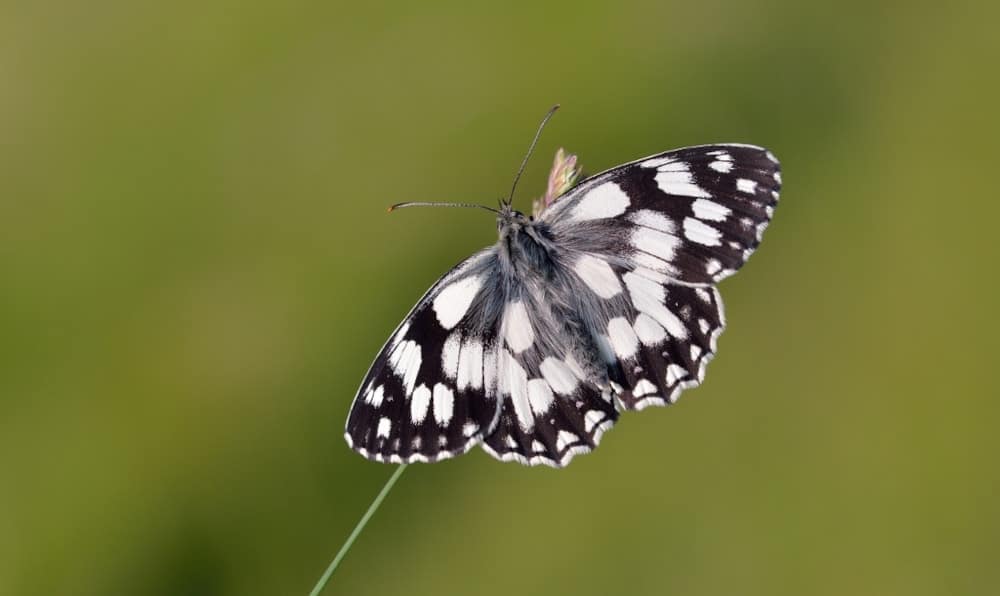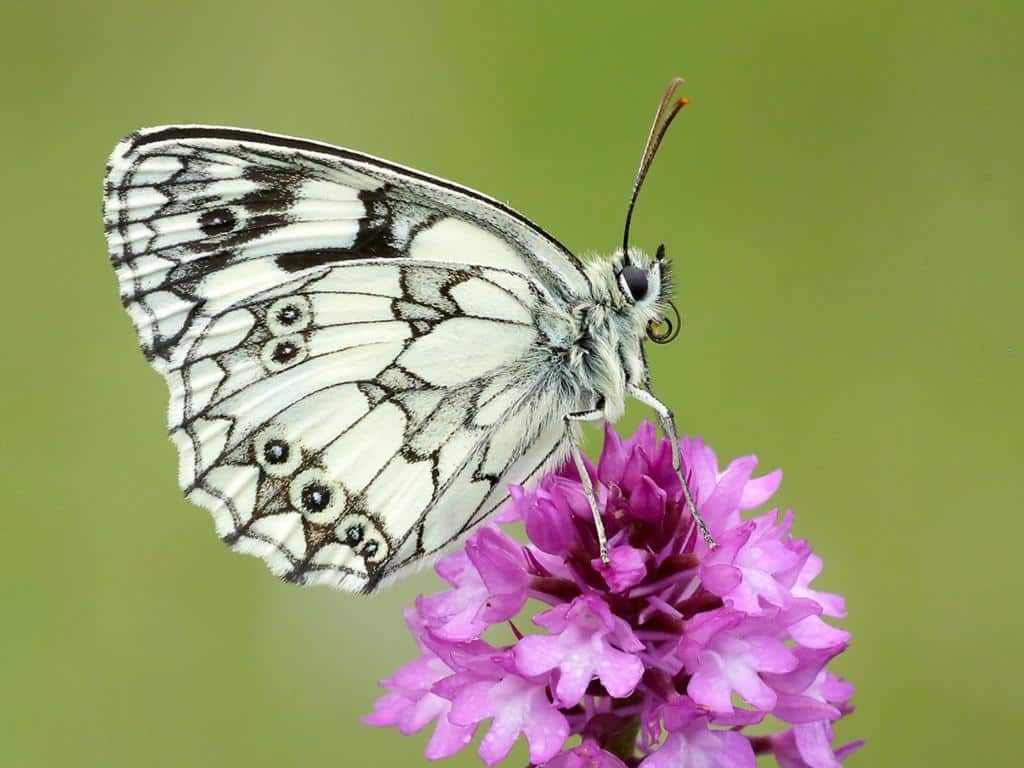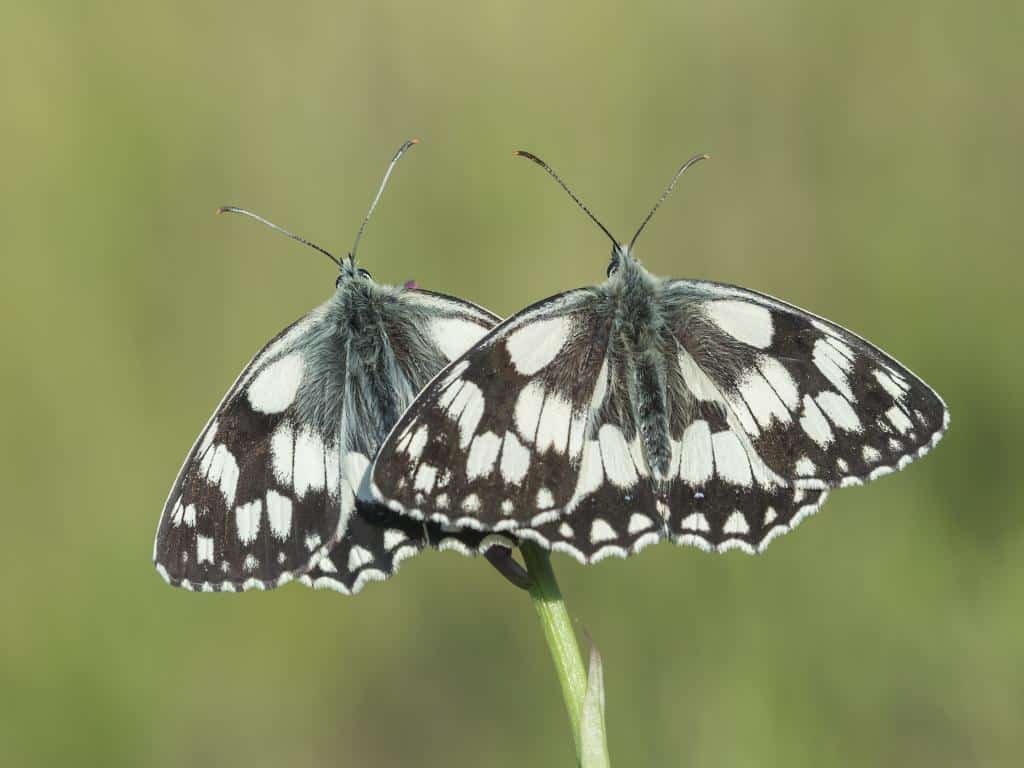The Marbled White Butterfly (Melanargia galathea) is an iconic species found across the UK and Europe. Recognised by its beautiful black and white marbled wing patterns, this butterfly has captivated the interest of nature enthusiasts for many years. Its unique colouration and patterns not only make it visually stunning, but also serve as a vital defence mechanism against potential predators.
Physical Characteristics
The Marbled White Butterfly, though named for its white appearance, is not a true white butterfly. It actually belongs to the brown butterfly family, Satyrinae. The most distinguishing feature of this butterfly is its black and white marbled pattern. The upper side of the wings displays an intricate design of black and white, which gives it its name. The underside of the wings, meanwhile, is predominantly white with a few black spots and markings, creating a stunning contrast.
In terms of size, the Marbled White Butterfly is a medium-sized butterfly, with a wingspan that ranges from 5.0 to 5.6 centimetres. It is this combination of size and striking appearance that makes it a favourite among butterfly watchers.

Behaviour
The Marbled White Butterfly exhibits several unique behaviours. As a daytime feeder, it primarily consumes nectar from a variety of flowers. One of its favourite nectar sources is the purple thistle, but it is also known to feed on knapweed, scabious, and other wildflowers. Its feeding habits are an essential component of its ecosystem, as it helps with pollination.
In flight, the Marbled White Butterfly displays a unique pattern. It glides through the air, interspersing its flight with short bursts of rapid wing beats. This combination of gliding and fluttering gives it a graceful and elegant appearance that is mesmerising to watch.
Habitat
Marbled White Butterflies prefer open grassland habitats. They can often be found in meadows, chalk downlands, and railway embankments. These butterflies are most commonly found in the southern and western parts of the UK, extending into Wales and even reaching Ireland. They have also been spotted in several countries across Europe.
Their preferred habitats are crucial for their survival. The grasses and wildflowers found in these areas provide them with the necessary food sources. Moreover, the open nature of these habitats allows them to engage in their unique flight patterns and behaviours.

Life Cycle
The life cycle of the Marbled White Butterfly is fascinating and intricate. It all begins with the female laying eggs on grass blades, where they remain throughout the winter months. The caterpillars emerge in the spring, feeding on various species of grasses, such as red fescue and sheep’s fescue.
After a period of growth, the caterpillar enters the pupation stage, forming a chrysalis attached to the grass. During this time, the caterpillar undergoes a transformation, eventually emerging as an adult butterfly.
Mating Behaviour
The mating behaviour of Marbled White Butterflies is equally intriguing. Males are known to patrol territories, engaging in aerial displays to attract females. Once a female shows interest, the two engage in a courtship dance. The male then releases pheromones to entice the female, and they proceed to mate. Following mating, the female searches for suitable grass blades to lay her eggs, thus starting a new generation of Marbled White Butterflies.

Migration and Dispersal
Marbled White Butterflies do not engage in long migrations. However, they can be quite mobile within their range, often moving to new areas in search of food and suitable habitats. Their movement patterns are influenced by factors such as habitat loss, climate change, and food availability. Preserving their preferred habitats is crucial to ensure their continued existence and ability to thrive.
Conservation
Fortunately, the Marbled White Butterfly is not currently under threat and has a stable population in the UK and Europe. However, habitat loss and climate change could potentially impact their numbers in the future. Conservation efforts are focused on maintaining and protecting their preferred grassland habitats, ensuring that these beautiful butterflies continue to grace our landscapes for years to come.
Interesting Facts
- The Marbled White Butterfly belongs to the brown butterfly family, Satyrinae, despite its name.
- These butterflies are known to engage in communal roosting, where several individuals gather together overnight on a single plant.
- The unique marbled pattern serves as a form of camouflage, helping the butterfly blend in with its grassland habitat.
- Marbled White Butterflies are most active on sunny days, when they can be seen nectaring on flowers and engaging in courtship rituals.
Conclusion
The Marbled White Butterfly is an iconic species that adds a touch of beauty and wonder to the UK and European landscapes. Its unique patterns and behaviours have long captivated nature enthusiasts and researchers alike. By protecting and preserving their preferred habitats, we can ensure that these stunning butterflies continue to thrive and bring joy to future generations.
Sam loves to learn about animals and their habitats. He has been a nature lover from a very young age, and has been writing papers and articles about wildlife for as long as he can remember.
